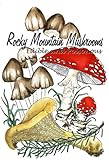Certainly there are thousands of mushroom guides from which to choose, but I thought I’d start by giving an overview of my early impressions of the following guides, all of which I received for my birthday from family and friends after my discovery of a big puffball sparked this recent obsession with mushroom hunting. At present, my foraging grounds generally include forested and above-treeline locales in the Rocky Mountains near Fairplay, Colorado.
Mushrooms of Colorado and the Southern Rocky Mountains by Vera Stucky Evenson with the Denver Botanic Gardens (1997, left), an out-of-print guide that Gregg bought me from Boulder Book Store through Amazon. (Incidentally, Amazon was selling the book for $128 to $215 yesterday, but they’re down to $25 now, so get it while the gettin’s good!) The book is tall, skinny, and colorful, with a pretty matte finish and good picture identifications. I’ve used it along with the others for all of my recent identifications, and I find much useful information therein. My only critique is some inconsistency in listing common names (sometimes it does; sometimes it doesn’t), which became important to me after I attended a local mushroom hike and the leader relied heavily on common names.
The Peterson Field Guide to Mushrooms (right) by Kent H. and Vera B. McKnight (1987), which uses detailed drawings instead of photos for the mushroom illustrations. This book appears to be very comprehensive and includes illustrations of more than 500 different mushrooms; the puffball section alone is blowing my mind. Who knew there were so many different kinds of puffballs!
The Audubon Society Field Guide to North American Mushrooms by famed mushroom-hunter Gary H. Lincoff (1981, left), a comprehensive picture-plate-filled guide that also has technical descriptions printed on leaf-thin, slightly transparent pages like a Bible. I grew up with this book and asked mom to send her copy to me on my birthday, which she did! The pictures are very good, and the guide includes more than 700 different mushrooms. I tried to find out if a more recent printing existed, but my research has proved fruitless thus far. I do know from an article in the Denver Post that Gary Lincoff did a Colorado mushroom hike with the North American Mycological Society recently–and Vera Evenson, author of Mushrooms of Colorado (above) and curator of the Denver Botanic Gardens’ fungi herbarium, was also there!
All That the Rain Promises and More…A Hip Pocket Guide to Western Mushrooms (1991, right) by David Arora, a nutty, pocket-sized guide with all sorts of random mushroom-related anecdotes and crazy yet refreshingly varied pictures of mycophagists from all walks of life enjoying their mushrooms and mushroom-hunting. We were recommended this insane gem of a book by the woman (Hlavaty?) who led us on a “Can I Eat This? Mushroom Hike” in Keystone, Colorado, as an extended education class offered through Colorado Mountain College. The information is very useful and I enjoy the humorous wordplay. This is from the introduction, where Arora explains the purpose of his “hip pocket guide” in contrast to his earlier, more voluminous book, Mushrooms Demystified: “The approximately 200 depicted here are those most likely to pique the interest of the average wonderer and wanderer. A more comprehensive treatment isn’t practical in a book this size. Witness my joy and pride, the comprehensive guide Mushrooms Demystified. It is eminently quotable but not notable for being totable.” Hah!
Rocky Mountain Mushrooms: Edible and Poisonous (left), a small, brightly hand-painted and hand-lettered introductory guide to mushrooms by Millie Miller and Cyndi Nelson (1986). I love hand lettering and as such I find this little booklet quite visually appealing. I imagine it would make a lovely gift for the newly spore-producing mycophagist. The fact that it is geared towards Rocky Mountain fungus is particularly useful for me.
(Please note: If you click on any of the book cover images above, they will take you to Amazon.com. All purchases made at Amazon through my website–including books and any other shopping you do while you’re there–help in a small way to support this starving writer. Thanks!)






Leave a Reply